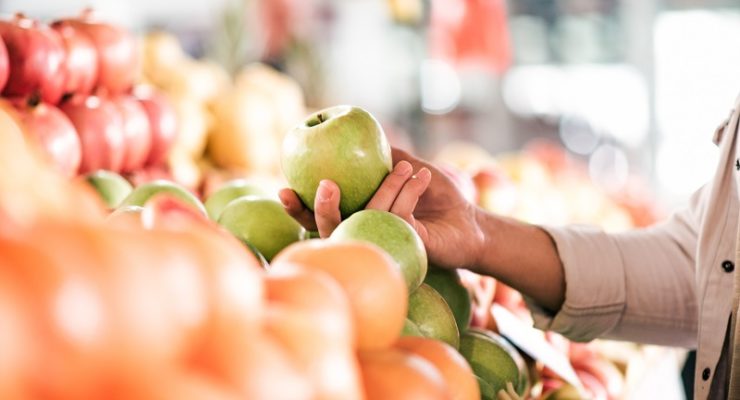Americans are eating healthy: Just ask them! According to Live Science, a Consumer Reports survey reveals that 90 percent of Americans think their diet is healthy. However, more than 70 percent of Americans are overweight or obese, according to the Centers for Disease Control and Prevention.
So, what gives? For one thing, certain foods can appear healthier than they are. It has become extremely common for products to be marketed as “natural” or “superfood” with little or no regulation. These are marketing terms and they work. In the United Kingdom, more than 60 percent of consumers say they’ve bought a “superfood” because it was marketed that way, says TheGaurdian.com.
Still, many more Americans are eating foods like kale, almonds and quinoa. And you know they’re munching on avocados! So, why are we not losing weight if our diets are “healthy”?
What Does “Healthy” Even Mean?

For starters, the definition is always changing. In 2016, the United States Food and Drug Administration (FDA) started redefining how it regulated the word “healthy” on food packaging. According to FoodDive.com, the change started after one company fought back when the FDA said its “healthy” bars had too much fat in them. The fat came from nuts in the bar, not from oils or other sources of fat, the company argued. And the FDA ultimately agreed.
The response helps explain what “healthy” food means for most Americans today: “Real” food that’s rich in nutrients that help fight off disease. These include foods like almonds, which help to fend off belly fat, says the Journal of Nutrition. According to the U.S. National Library of Medicine, other nuts, such as Cashews, are loaded with the types of monounsaturated fat that fueled the “healthy” debate about the bars mentioned earlier. The popular avocado provides potassium, which your body needs for heart function, explains Harvard Health. These nutritious ingredients have become increasingly popular as more people try eating healthy.
“Healthy” Foods and Weight Loss

Just because a food is rich in nutrients, doesn’t mean you can eat it with abandon if your goal is to shed pounds. Even a calorie from a “good,” “healthy” food is a calorie that your body has to burn or store. A half-cup of avocado might be rich in polyunsaturated fats that your body needs. However, according to the United States Department of Agriculture (USDA), it also has 192 calories—a fairly large percentage of many people’s daily diets. And if you snack mindless on almonds, the calories can add up even faster. A cup of those nuts is 828 calories, says the USDA. Adding an extra 800 calories to your diet can be the difference between moving towards your weight loss goal and packing on the pounds—even if it’s 800 calories of “healthy” food.
Slim Down with Proper Serving Sizes

With so much portion size confusion, successful weight loss plans like Nutrisystem become even more important for healthy eating. Our plans focus on what healthy foods are and how much you need to eat to lose weight. Nutrisystem diet meals and snacks are loaded with fiber, which aids in digestion and weight loss while helping you feel fuller for longer, says Healthline. They’re also packed with protein, which helps to build and maintain muscle and increase feelings of fullness. All of these foods are doled out in portions that provide the nutrients your body needs while keeping an eye on the calories your weight loss goals require.
If you’re not eating pre-portioned foods, portion control may be a little more difficult. One study, published in the European Journal of Clinical Nutrition, found that Americans guess serving sizes correctly only about half of the time. Study participants estimated snack, cereal, fruit and vegetable serving sizes to be bigger than they actually are. Bread and cold cut serving sizes were estimated to be smaller than they are.
The Nutrisystem Grocery Guide tells you exactly how much of a “healthy” food you can eat—like almonds, avocados, cashews and more. With easy-to-follow PowerFuel and SmartCarb guidelines, you can budget these foods into your daily diet and eat proper portions even after you’ve reached your goal weight.
The Grocery Guide also has your list of maybe the “healthiest” foods of all—non-starchy vegetables. In a study of more than 130,000 people, published in The Lancet, scientists found that eating three or four servings of vegetables per day resulted in the lowest rates of premature death. On the Nutrisystem program, non-starchy veggies are “unlimited” due to their low-calorie count. This means they aren’t just “healthy”—they’re healthy in larger portions that you can enjoy as much as you’d like. So, you can eat healthy, stay satisfied AND lose weight!
What are you waiting for? Get started on your weight loss journey today! >
The post Eating “Healthy”? The Real Reason You’re Not Losing Weight appeared first on The Leaf.
from The Leaf https://ift.tt/2tv2MWG



No comments:
Post a Comment